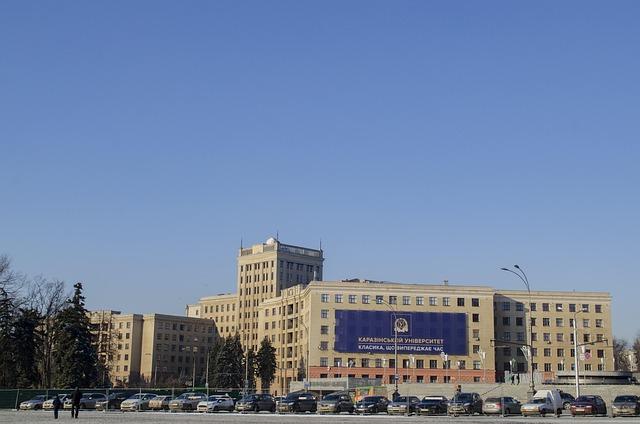In a landscape where innovation and discovery are paramount, the push and pull of political decisions can have far-reaching consequences. As the United States continues to grapple with the legacy of the Trump administration, one area of particular concern has emerged: the future of scientific research and education. Universities across the nation are finding themselves at a crossroads, feeling the impact of budget cuts and policy shifts that threaten to stifle the next generation of scientists. In this article, we delve into the worries of educators and researchers as they navigate the challenges posed by reduced funding, the implications for academic inquiry, and the broader fears of fostering a ‘lost generation’ in the realm of science. As we explore the landscape of higher education today, the question looms large: what will it take to ensure that a new wave of scientific minds can thrive in an uncertain future?
Impact of Funding Cuts on Research Initiatives and Academic Growth

The recent funding cuts have sent shockwaves through academic institutions, stifling research initiatives that are essential for scientific advancement. Many universities are now facing significant resource constraints that limit their ability to pursue innovative projects and attract top-tier talent. This troubling trend has created an environment where emerging scientists may find it increasingly difficult to secure the support necessary to realize their potential. As a result, academic growth is witnessing a discouraging slowdown, particularly in fields that depend heavily on federal grants and funding.
Moreover, these fiscal challenges have led to difficult decisions regarding staffing and program maintenance. Many vital research programs are being curtailed or canceled altogether, placing an unnecessary strain on departments already grappling with budgetary issues. Some key consequences include:
- Decreased student enrollment in research-centric disciplines
- Reduced opportunities for undergraduate research experiences
- Increased competition for fewer available research positions
In an effort to illustrate the scale of the impact, consider the following table highlighting anticipated changes in funding sources before and after the cuts:
| Funding Source | Before Cuts | After Cuts |
|---|---|---|
| Federal Grants | $10 Billion | $7 Billion |
| Private Donations | $2 Billion | $1.5 Billion |
| State Allocations | $3 Billion | $1 Billion |
The stark reduction in available funds not only jeopardizes current research initiatives but also poses a long-term threat to the future of scientific discovery. As universities struggle to cope with these funding cuts, they face the looming prospect of cultivating a generation of scholars who may not have access to the resources needed for meaningful contributions to their fields. Ensuring a stable and nurturing environment for scientific inquiry is paramount to preventing a setback that could last for decades.
Challenges Faced by Emerging Scientists in a Resource-Deprived Environment

The current landscape for emerging scientists is fraught with hurdles that threaten to derail their ambitions and futures. Limited funding opportunities have severely affected research projects essential for education and innovation. As research grants are slashed, the burden of finding financial support falls heavily on young scholars who often lack the established networks and reputation necessary to secure alternative funding sources. In addition, the pressure to publish in prestigious journals has intensified, but with fewer resources at their disposal, the quality of research often suffers, leading to a frustrating cycle that stifles creativity and discovery.
Moreover, access to mentorship has significantly dwindled, creating a gap between experienced professionals and their novice counterparts. Senior researchers, overwhelmed by their own responsibilities and diminished resources, have less time and energy to devote to guiding emerging talents. This disruption fosters isolation among young scientists, who simultaneously grapple with academic pressures and a lack of support. Without proper mentorship, the transfer of knowledge and innovative ideas is stymied, resulting in a generation struggling to carve their niche in the scientific community.
The decline in institutional support also extends to essential infrastructure, such as laboratories and technology. Many institutions facing budget cuts have had to make difficult decisions, leading to outdated equipment and diminished research capabilities. In this environment, the competitiveness of emerging scientists diminishes as they lack the necessary tools to explore groundbreaking avenues in their fields. As resource disparities widen, collaboration between institutions becomes critical yet challenging, further exacerbating the feeling of desolation within this nascent scientific community.
Strategies for Universities to Adapt and Sustain Scientific Innovation

In a rapidly evolving scientific landscape, universities must embrace innovative approaches to not only adapt but also thrive. Key strategies include fostering collaborative research among departments, aligning with industry partners, and integrating interdisciplinary programs. By promoting partnerships between faculties, institutions can pool resources and expertise, enhancing research capabilities and attracting diverse funding sources.
Additionally, universities should focus on providing flexible funding options that cater to the diverse needs of researchers. Implementing grant programs that support early-stage projects or startup costs can stimulate innovation at the grassroots level. Establishing incubators and accelerators within campus settings allows scientists and entrepreneurs to work closely, turning novel ideas into viable commercial products. This approach not only sustains scientific innovation but also prepares students for the current job market.
Lastly, investing in advanced training for faculty and students is crucial. Providing workshops, seminars, and online courses that emphasize emerging technologies and methodologies will ensure that researchers stay at the forefront of science. Not only will this keep the university competitive, but it will also reinforce a culture of continuous learning and adaptability among the scientific community.
Collaborative Efforts to Support Future Generations of Researchers

In response to the uncertainties stemming from recent funding cuts, numerous universities are uniting to foster resilient networks aimed at nurturing the next generation of scientific minds. These collaborative efforts are more than just safety nets; they are essential frameworks designed to prevent a severe brain drain and ensure that talent continues to thrive in the face of adversity. Institutions are pooling resources, sharing facilities, and creating synergies that maximize the impact of available funding.
Among the initiatives being implemented, interdisciplinary research projects are gaining prominence. By breaking down barriers between departments and disciplines, universities are fostering an inclusive environment where innovation can flourish. This collaborative approach not only enriches the educational experience but also equips students with diverse skill sets that are increasingly necessary in the evolving landscape of science. Key components of these initiatives include:
- Joint grant applications to bolster funding opportunities.
- Shared mentorship programs that connect experienced researchers with early-career scientists.
- Networking events that facilitate collaboration between academic and industry leaders.
Furthermore, universities are stepping up advocacy efforts to restore funding for scientific research and education at federal and state levels. These coordinated campaigns involve partnerships with professional organizations, advocacy groups, and even student-led initiatives. A systematic approach to lobbying can help reinforce the importance of sustaining scientific inquiry for future generations. For a more structured view of these advocacy efforts and their objectives, the table below summarizes the key goals:
| Goal | Description |
|---|---|
| Increase Funding | Restore and enhance federal support for research grants. |
| Promote STEM Education | Expand programs that incentivize STEM education at all levels. |
| Support for Underrepresented Groups | Implement initiatives aimed at diversifying the scientific community. |
In Conclusion
As we stand at the crossroads of education and innovation, the consequences of political decisions loom large over the future of scientific exploration. The recent budget cuts implemented during the Trump administration have not only strained the resources of universities but have also cast a long shadow on the aspirations of countless budding scientists. With each underfunded program and dwindling research grant, the fear of a ‘lost generation’ in the realm of science becomes increasingly palpable.
It is crucial that we recognize the stakes at play—not just for the institutions themselves, but for society at large, which relies on scientific advancement to address pressing challenges, from climate change to public health crises. The resilience of academic communities will be tested in the years to come, as they navigate these turbulent waters with limited resources.
Looking ahead, the urgency for advocacy and reform cannot be understated. As we advocate for policies that prioritize education and research funding, we must also ensure that the next generation of scientists experiences the encouragement and support necessary to flourish. The future of science depends on the choices we make today. Let us move forward with the intent to uplift and empower, turning potential despair into a platform for renewed growth and discovery. The journey may be fraught with challenges, but it is also ripe with opportunity—a chance to redefine what it means to pursue knowledge in an ever-evolving world.






























